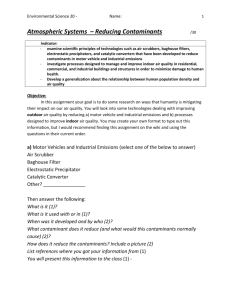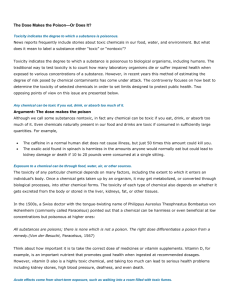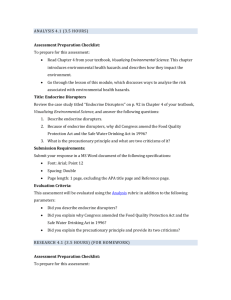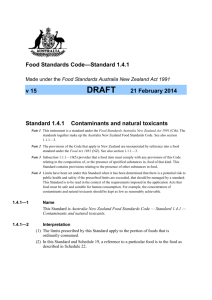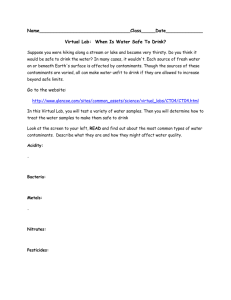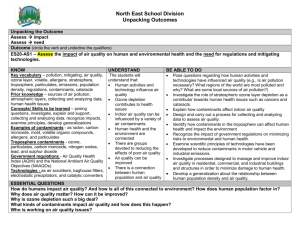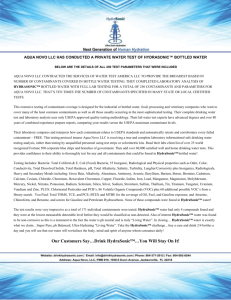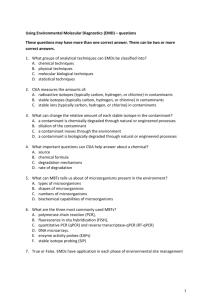Reading - Risk, Exposure & Health
advertisement
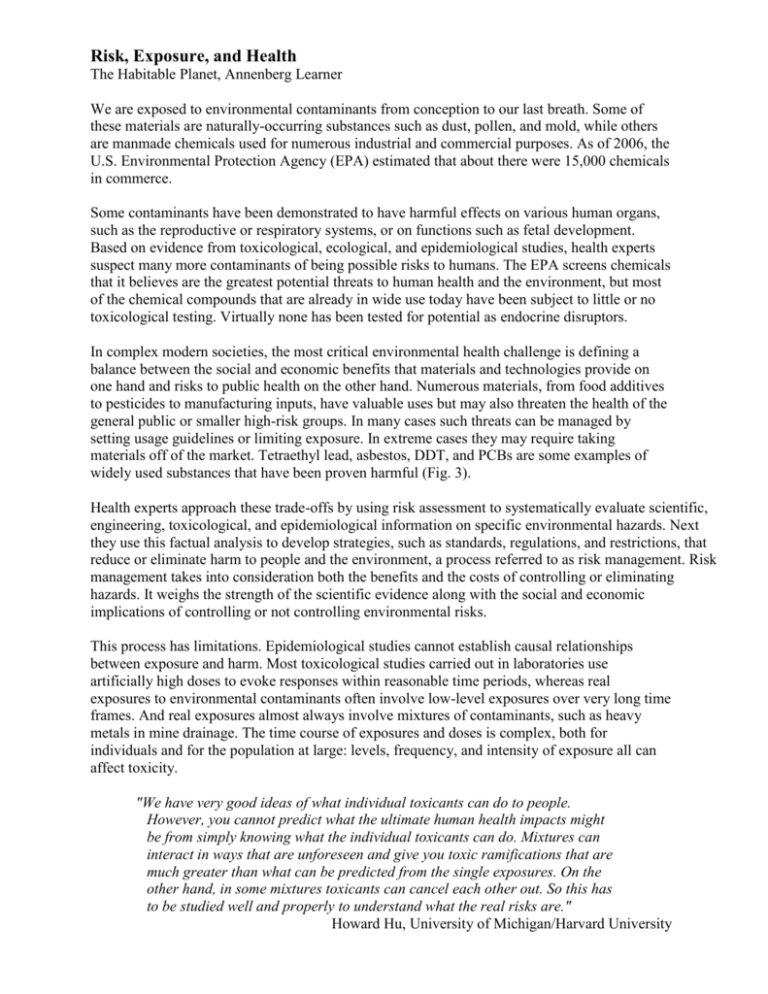
Risk, Exposure, and Health The Habitable Planet, Annenberg Learner We are exposed to environmental contaminants from conception to our last breath. Some of these materials are naturally-occurring substances such as dust, pollen, and mold, while others are manmade chemicals used for numerous industrial and commercial purposes. As of 2006, the U.S. Environmental Protection Agency (EPA) estimated that about there were 15,000 chemicals in commerce. Some contaminants have been demonstrated to have harmful effects on various human organs, such as the reproductive or respiratory systems, or on functions such as fetal development. Based on evidence from toxicological, ecological, and epidemiological studies, health experts suspect many more contaminants of being possible risks to humans. The EPA screens chemicals that it believes are the greatest potential threats to human health and the environment, but most of the chemical compounds that are already in wide use today have been subject to little or no toxicological testing. Virtually none has been tested for potential as endocrine disruptors. In complex modern societies, the most critical environmental health challenge is defining a balance between the social and economic benefits that materials and technologies provide on one hand and risks to public health on the other hand. Numerous materials, from food additives to pesticides to manufacturing inputs, have valuable uses but may also threaten the health of the general public or smaller high-risk groups. In many cases such threats can be managed by setting usage guidelines or limiting exposure. In extreme cases they may require taking materials off of the market. Tetraethyl lead, asbestos, DDT, and PCBs are some examples of widely used substances that have been proven harmful (Fig. 3). Health experts approach these trade-offs by using risk assessment to systematically evaluate scientific, engineering, toxicological, and epidemiological information on specific environmental hazards. Next they use this factual analysis to develop strategies, such as standards, regulations, and restrictions, that reduce or eliminate harm to people and the environment, a process referred to as risk management. Risk management takes into consideration both the benefits and the costs of controlling or eliminating hazards. It weighs the strength of the scientific evidence along with the social and economic implications of controlling or not controlling environmental risks. This process has limitations. Epidemiological studies cannot establish causal relationships between exposure and harm. Most toxicological studies carried out in laboratories use artificially high doses to evoke responses within reasonable time periods, whereas real exposures to environmental contaminants often involve low-level exposures over very long time frames. And real exposures almost always involve mixtures of contaminants, such as heavy metals in mine drainage. The time course of exposures and doses is complex, both for individuals and for the population at large: levels, frequency, and intensity of exposure all can affect toxicity. "We have very good ideas of what individual toxicants can do to people. However, you cannot predict what the ultimate human health impacts might be from simply knowing what the individual toxicants can do. Mixtures can interact in ways that are unforeseen and give you toxic ramifications that are much greater than what can be predicted from the single exposures. On the other hand, in some mixtures toxicants can cancel each other out. So this has to be studied well and properly to understand what the real risks are." Howard Hu, University of Michigan/Harvard University Genetic variability in the population adds to the uncertainty of risk assessment. Interactions between humans' genetic makeup and their environment take many forms, including characteristics that either protect individuals from specific risks or make them more susceptible. Both inherited genetic traits and environmental exposures can create genetic susceptibilities, which can then be transferred from one generation to another. To be effective, risk management must take these uncertainties and sources of variability into account in developing strategies. Managing risks also involves political and philosophical issues. Governments have often acted regardless of the actual magnitude of a risk because of risk perceptions on the part of special interest groups or the general public. Risk Analysis and Assessment Health and environmental experts use risk analysis to assess many types of threats, from infectious agents to noise pollution. The process has several components (Fig. 4). Risk assessment: Scientists identify hazards, determine dose-response relationships, and estimate actual or projected exposures. These steps lead to an estimate of overall risk to the general population or target groups. Risk management: Experts develop options for limiting estimated risk. Unlike risk assessment, which is based on scientific findings, risk management takes political and economic factors into account along with technical considerations. Risk communication: Policy makers discuss the problem and options for addressing it with the public, then incorporate the feedback that they receive into their decisions. As discussed below in section 7, "Benefit-Cost Analysis and Risk Tradeoffs," effective risk communication helps to ensure that decisions will be broadly acceptable. Environmental risk assessments typically include four steps. Hazard identification: Determining whether or not exposure to an agent causes health problems. Researchers often address this question by testing the agent to see whether it causes cancer or other harmful effects in laboratory animals. Dose-response assessment: Characterizing the relationship between receiving a dose of the agent and experiencing adverse effects. Analysts often have to extrapolate from high laboratory doses to low actual doses and from laboratory animals to humans. Exposure assessment: Measuring or estimating how often humans are exposed to the agent, for how long, and the intensity of exposure. This can involve methods such as asking subjects about their lifestyles and habits; taking environmental samples; and screening subjects' blood, urine, hair, or other physical samples to measure concentrations of the agents in their bodies (Fig. 6). Risk characterization: Combining exposure and dose-response assessments to estimate health impacts on subjects. Many hazardous materials are present in our environment, but some are more likely to cause actual harm than others. Humans come into contact with harmful agents in many ways. For example, we may inhale gases and particulates as we breathe, eat fruit that carries pesticide residues, drink polluted water, touch contaminated soils, or absorb radiation or chemical vapors through our skin. In each case, risk analysts want to measure several variables. Exposure: Contact between a contaminant and the exterior of an exposed person's body (skin and openings into the body such as mouth, nostrils, and cuts or breaks in the skin). Intake or uptake: The processes through which contaminants cross the boundary from outside to inside the body. Intake refers to processes like ingestion and inhalation that physically move the agent through an opening in the outer body, such as the mouth, nose, or a skin puncture. Uptake involves absorption of agents through the skin. Dose: The amount of contaminant that is inhaled or ingested into an exposed person's body or applied to the skin (potential dose), and the fraction of this dose that is absorbed and becomes available to impact biologically significant sites inside the body (internal dose) Studying Risk Exposure Exposure pathways for radioactive chemicals and materials from a nuclear waste storage facility Courtesy United States Department of Energy/Hanford site. As this summary indicates, exposure assessment is a painstaking multi-step process that requires a lot of data. Researchers need to know the contaminant's physical and chemical properties, the form in which it occurs locally, the medium by which it comes into contact with humans, and how concentrated it is within that medium. They also need to know the demographics of the exposed population, major routes of exposure for that group, and relevant behavior and lifestyle issues, such as how many people smoke cigarettes or filter their tap water. And calculating the human impact of contact with hazardous agents requires detailed knowledge of physiology and toxicology. Epidemiologists analyze how health-related events are distributed in specific human populations—who gets sick with what illnesses, when, and where. By comparing groups with different illness rates and looking at demographic, genetic, environmental, and other differences among these groups, epidemiologists seek to determine how and why certain groups get sick. These studies are designed to inform public health policies and help prevent further harm. What if the risk comes from a chemical that has not been studied yet, or has only been studied in a few small groups? In such cases analysts use information from animal toxicology studies, which can measure associations between contaminants and health effects in thousands of animal subjects quickly and inexpensively (relatively speaking—major animal studies can take several years and cost millions of dollars). But animal data also has its drawbacks. Toxicology studies typically use large doses to produce a measurable response quickly, while environmental exposures usually occur at low levels over long periods of time, so analysts have to extrapolate from high study doses to low real-world doses. They also have to extrapolate from observed results in animals to expected results in humans, which assumes that a contaminant will affect humans in the same way. However, epidemiology and animal studies can inform each other. Cancer is a major focus of environmental risk analysis for several reasons. First, it is a leading cause of death in developed countries that have passed through the demographic transition and brought other threats such as infectious disease and malnutrition under control. Second, environmental exposures broadly defined account for a substantial fraction of cancers—at least two-thirds of all cases in the United States, according to the National Institutes of Health.This estimate includes all influences outside the body, including many lifestyle choices such as smoking and eating a high-fat diet. Risk analyses have led to bans or use restrictions on carcinogens such as benzene (a solvent), asbestos (an insulating fiber), and a number of pesticides, and have contributed to the development of guidelines and workplace standards that minimize exposure to other known or suspected carcinogens. Environmental contaminants cause many harmful effects in addition to cancer, such as toxicity, birth defects, reduced immune system function, and damage to other organs and physical systems. For non-carcinogens, researchers assume that a threshold exists below which no harmful effects are likely to occur in humans. To quantify these values, scientists first seek to identify the so-called no observable adverse effects level (NOAEL), which is the highest exposure among all available studies at which no toxic effect was observed. The EPA then sets reference doses for ingestion and reference concentrations for inhalation that represent levels at which humans can be exposed to chemicals for specific periods of time without suffering adverse health effects. These limits are fairly conservative because they incorporate uncertainty factors and assume that people may be exposed daily or constantly throughout their lives. The Cost of Environmental Health Regulators also set limits for specific types of exposures. For example, the EPA establishes guidelines for pesticide residues in food, and the Agency for Toxic Substances and Disease Registry establishes minimal risk levels (MRLs) for acute, intermediate, and chronic exposure to contaminants at hazardous waste sites. Cost-benefit analyses also set values on environmental impacts, such as improved visibility in scenic areas or protection of undeveloped land as wilderness. Sometimes monetizing these effects is straightforward because people pay for access to the resource and demand is likely to drop if the resource becomes less attractive. For example, researchers have assessed the economic impact of air pollution in national parks by measuring how sharply pollution events reduce visits to parks and calculating the resulting lost revenues, both at the park and in surrounding communities. Risk Management Many risk-management choices involve risk-risk tradeoffs—choosing between options that each may cause some harm. We make risk-risk tradeoffs every day. Some are personal choices, such as pursuing an intensive exercise program which has cardiovascular benefits but could lead to injuries. Others involve broad social regulations. For example, some environmental groups support an international ban on the insecticide DDT because of its toxic human and animal health effects, but many public health agencies argue that this step would make it very difficult to control malaria in the developing world. Regulators may consider many criteria when they confront risk-risk tradeoffs and have to decide which risks are and are not acceptable. Important factors include both the probability of a risk and whether its consequences would be negligible, moderate, or serious. Expert assessments and public perceptions of risk are not always the same. Decision makers need to understand factors that influence how people understand and interpret risk information for several reasons. First, public concerns may influence research and development priorities, such as which chemicals to analyze in toxicity studies. Second, individual behavior choices are guided by risk avoidance, so if experts want people to avoid certain risks, they need to understand whether the public sees those actions as dangerous. If the public views a risky activity as benign, officials may have to develop public-education campaigns to change those perceptions. Communicating risk information to the public is an important part of risk management. In the early decades of environmental regulation, public communication often took what critics called the "decide, announce, defend" approach: agencies developed policies and released their final results to the public and regulated industries. But since risk analysis involves many uncertainties, assumptions, and judgments, it requires policy makers to explain clearly how decisions are reached—especially if the issue involves risks that laypeople perceive differently from scientific experts. Often effective risk communication means involving the public in the decision process, not just informing people at the end. Public involvement in risk decisions can take many forms. In early planning stages, it can help regulators identify the issues that citizens care most about, how much risk they will tolerate, and what they view as acceptable mitigation costs. Stakeholders may also take part in implementing decisions. The Precautionary Principle Under the basic risk analysis model, regulators quantify risks and compare the costs and benefits of various control options before they set limits on hazards. However, over the past several decades some governments have formally adopted a different approach called the Precautionary Principle as a guideline. This view holds that governments should not wait to limit contaminants in food, water, air, or commercial products until scientific studies have reduced uncertainties about exposure and effects. The Precautionary Principle has taken root most strongly in the European Union (EU). In 2000 the EU issued a communiqué stating that the principle applied "where scientific evidence is insufficient, inconclusive, or uncertain and preliminary scientific evidence indicates that there are reasonable grounds for concern that the potentially dangerous effects on the environment, human, animal, or plant health may be inconsistent with the high level of protection chosen by the EU." European regulators have invoked the Precautionary Principle to support steps such as banning imported beef treated with hormones and adopting the Restriction of Hazardous Substances Directive, which requires electronics manufacturers to remove lead, mercury, cadmium, and other hazardous substances from most of their products The Precautionary Principle plays a much weaker role in U.S. environmental regulation, which generally assumes that some level of risk from exposure to contaminants is acceptable and sets controls intended to limit pollution to those levels. Unlike the EU, the United States does not require comprehensive product testing or labeling. However, some U.S. laws take a precautionary approach in more limited areas. For example, new drugs must be tested before they can be sold, and the National Environmental Policy Act requires environmental impact assessments for any major projects that are federally funded, with an obligation to consider alternatives including no action. Some states and cities have adopted regulations that take a precautionary approach to policies such as using pesticides in schools or funding new technologies. For the most part, though, U.S. environmental laws require some scientific proof of harm as a basis for protective action.
